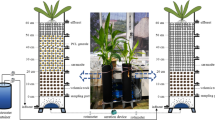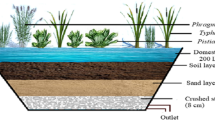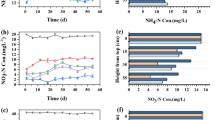Abstract
Water quality standard for nitrate becomes more and more strict, and the plant carbon source is widely used for denitrification by constructed wetland (CW) and bioreactor. However, the nitrate removal efficiency by different types of plant carbon source are not evaluated comprehensively. Denitrification performance of different plant carbon sources, and the influence of dosing method and pretreatment are thoroughly reviewed in this paper, which aims to investigate the accurate utilization of plant carbon source for nitrogen (as nitrate) removal. It is concluded that plant carbon source addition for all types of CWs and bioreactors can improve the nitrate removal efficiency to some extent, and the dosing method of plant carbon source for denitrification should be further studied and optimized in the future. The popular carbon sources for CW and bioreactor denitrification enhancement are woodchip, chopped macrophytes, crop plants, macrophytes litters, etc. The recommended optimum C:N ratios for CW and bioreactor are 4.0:5.0 and 1.8:3.0, respectively. The physical and biological pretreatments are selected to supply organic carbon for long-term denitrification.
Similar content being viewed by others
References
Aerts R, de Caluwe H (1997) Nutritional and plant-mediated controls on leaf litter decomposition of Carex species. Ecology 78:244–260
ÆsØy A, Ødegaard H, Bach K, Pujol R, Hamon M (1998) Denitrification in a packed bed biofilm reactor (BIOFOR)—experiments with different carbon sources. Water Res 32:1463–1470
Akunna JC, Bizeau C, Moletta R (1993) Nitrate and nitrite reductions with anaerobic sludge using various carbon sources: glucose, glycerol, acetic acid, lactic acid and methanol. Water Res 27:1303–1312
Aslan Ş, Türkman A (2004) Simultaneous biological removal of endosulfan (α + β) and nitrates from drinking waters using wheat straw as substrate. Environ Int 30:449–455
Bachand PA, Horne AJ (1999) Denitrification in constructed free-water surface wetlands: II. Effects of vegetation and temperature. Ecol Eng 14:17–32
Ballantine KA, Groffman PM, Lehmann J, Schneider RL (2014) Stimulating nitrate removal processes of restored wetlands. Environ Sci Technol 48:7365–7373
Bastviken SK, Eriksson P, Premrov A, Tonderski K (2005) Potential denitrification in wetland sediments with different plant species detritus. Ecol Eng 25:183–190
Beauchamp E, Trevors J, Paul J (1989) Carbon sources for bacterial denitrification, advances in soil science. Springer, pp. 113-142
Beutel MW, Newton CD, Brouillard ES, Watts RJ (2009) Nitrate removal in surface-flow constructed wetlands treating dilute agricultural runoff in the lower Yakima Basin, Washington. Ecol Eng 35:1538–1546
Bezbaruah AN, Zhang TC (2003) Performance of a constructed wetland with a sulfur/limestone denitrification section for wastewater nitrogen removal. Environ Sci Technol 37:1690–1697
Białowiec A, Janczukowicz W, Randerson PF (2011) Nitrogen removal from wastewater in vertical flow constructed wetlands containing LWA/gravel layers and reed vegetation. Ecol Eng 37:897–902
Białowiec A, Davies L, Albuquerque A, Randerson PF (2012) Nitrogen removal from landfill leachate in constructed wetlands with reed and willow: redox potential in the root zone. J Environ Manag 97:22–27
Bremner J, Shaw K (1958) Denitrification in soil II factors affecting denitrification. J Agric Sci 51:40–52
Brix H (1999) How “green” are aquaculture, constructed wetlands and conventional wastewater treatment systems? Water Sci Technol 40:45–50
Brix H, Arias CA (2005a) Danish guidelines for small-scale constructed wetland systems for onsite treatment of domestic sewage. Water Sci Technol 51:1–9
Brix H, Arias CA (2005b) The use of vertical flow constructed wetlands for on-site treatment of domestic wastewater: new Danish guidelines. Ecol Eng 25:491–500
Cadisch G, Giller KE (1997) Driven by nature: plant litter quality and decomposition. CAB international
Cameron SG, Schipper LA (2010) Nitrate removal and hydraulic performance of organic carbon for use in denitrification beds. Ecol Eng 36:1588–1595
Carleton J, Grizzard T, Godrej A, Post H (2001) Factors affecting the performance of stormwater treatment wetlands. Water Res 35:1552–1562
Chen Y, Wen Y, Cheng J, Xue C, Yang D, Zhou Q (2011) Effects of dissolved oxygen on extracellular enzymes activities and transformation of carbon sources from plant biomass: implications for denitrification in constructed wetlands. Bioresour Technol 102:2433–2440
Chen Y, Wen Y, Zhou Q, Vymazal J (2014a) Effects of plant biomass on denitrifying genes in subsurface-flow constructed wetlands. Bioresour Technol 157:341–345
Chen Y, Wen Y, Zhou Q, Vymazal J (2014b) Effects of plant biomass on nitrogen transformation in subsurface-batch constructed wetlands: a stable isotope and mass balance assessment. Water Res 63:158–167
Christensson M, Lie E, Welander T (1994) A comparison between ethanol and methanol as carbon sources for denitrification. Water Sci Technol 30:83–90
Clifford D, Liu X (1993) Biological denitrification of spent regenerant brine using a sequencing batch reactor. Water Res 27:1477–1484
Davis L (1995) A handbook of constructed wetlands: a guide to creating wetlands for: agricultural wastewater, domestic wastewater, coal mine drainage, stormwater in the Mid-Atlantic Region
Della Rocca C, Belgiorno V, Meriç S (2007) Cotton-supported heterotrophic denitrification of nitrate-rich drinking water with a sand filtration post-treatment. Water SA 31:229–236
Ding Y, Song X, Wang Y, Yan D (2013) Effect of supplying a carbon extracting solution on denitrification in horizontal subsurface flow constructed wetlands. Korean J Chem Eng 30:379–384
Domingos S, Boehler K, Felstead S, Dallas S, Ho G (2009) Effect of external carbon sources on nitrate removal in constructed wetlands treating industrial wastewater: woodchips and ethanol addition
Fernández-Nava Y, Marañón E, Soons J, Castrillón L (2010) Denitrification of high nitrate concentration wastewater using alternative carbon sources. J Hazard Mater 173:682–688
Gersberg R, Elkins B, Goldman C (1983) Nitrogen removal in artificial wetlands. Water Res 17:1009–1014
Gersberg R, Elkins B, Lyon S, Goldman C (1986) Role of aquatic plants in wastewater treatment by artificial wetlands. Water Res 20:363–368
Glass C, Silverstein J (1998) Denitrification kinetics of high nitrate concentration water: pH effect on inhibition and nitrite accumulation. Water Res 32:831–839
Hamersley MR, Howes BL (2002) Control of denitrification in a septage-treating artificial wetland: the dual role of particulate organic carbon. Water Res 36:4415–4427
Huett D, Morris S, Smith G, Hunt N (2005) Nitrogen and phosphorus removal from plant nursery runoff in vegetated and unvegetated subsurface flow wetlands. Water Res 39:3259–3272
Hume NP, Fleming MS, Horne AJ (2002) Denitrification potential and carbon quality of four aquatic plants in wetland microcosms. Soil Sci Soc Am J 66:1706–1712
Ingersoll TL, Baker LA (1998) Nitratfe removal in wetland microcosms. Water Res 32:677–684
IWA (2001) Constructed wetlands for pollution control: processes, performance, design and operation. Iwa Publishing
Kozub D, Liehr S (1999) Assessing denitrification rate limiting factors in a constructed wetland receiving landfill leachate. Water Sci Technol 40:75–82
Kumar P, Barrett DM, Delwiche MJ, Stroeve P (2009) Methods for pretreatment of lignocellulosic biomass for efficient hydrolysis and biofuel production. Ind Eng Chem Res 48:3713–3729
Lee NM, Welander T (1996) The effect of different carbon sources on respiratory denitrification in biological wastewater treatment. J Ferment Bioeng 82:277–285
Li B, Irvin S, Baker K (2007) The variation of nitrifying bacterial population sizes in a sequencing batch reactor (SBR) treating low, mid, high concentrated synthetic wastewater. J Environ Eng Sci 6:651–663
Liehr SK, Kozub D, Rash J, Sloop G, Doll B, Rubin A, House C, Hawes S, Burks D (2000) Constructed wetlands treatment of high nitrogen landfill leachate. Water Environment Research Foundation
Lin Y-F, **g S-R, Wang T-W, Lee D-Y (2002) Effects of macrophytes and external carbon sources on nitrate removal from groundwater in constructed wetlands. Environ Pollut 119:413–420
Liu G, Wen Y, Zhou Q (2010) Nitrate removal in horizontal subsurface constructed wetland with cattail litter addition, bioinformatics and biomedical engineering (iCBBE), 2010 4th international conference on. IEEE pp 1-4
MacDonald DV (1990) Denitrification by fluidized biofilm reactor. Water Sci Technol 22:451–461
Matějů V, Čižinská S, Krejčí J, Janoch T (1992) Biological water denitrification—a review. Enzym Microb Technol 14:170–183
McMillan JD (1994) Pretreatment of lignocellulosic biomass, ACS symposium series (USA)
Mirvish SS (1977) N-nitroso compounds, nitrite and nitrate: possible implications for the causation of human cancer. Prog Water Technol 8:195
Mosier N, Wyman C, Dale B, Elander R, Lee Y, Holtzapple M, Ladisch M (2005) Features of promising technologies for pretreatment of lignocellulosic biomass. Bioresour Technol 96:673–686
Obaja D, Mace S, Mata-Alvarez J (2005) Biological nutrient removal by a sequencing batch reactor (SBR) using an internal organic carbon source in digested piggery wastewater. Bioresour Technol 96:7–14
Ovez B (2006) Batch biological denitrification using Arundo donax, Glycyrrhiza glabra, and Gracilaria verrucosa as carbon source. Process Biochem 41:1289–1295
Ovez B, Ozgen S, Yuksel M (2006) Biological denitrification in drinking water using Glycyrrhiza glabra and Arunda donax as the carbon source. Process Biochem 41:1539–1544
Park JBK, Craggs RJ, Sukias JPS (2008) Treatment of hydroponic wastewater by denitrification filters using plant prunings as the organic carbon source. Bioresour Technol 99:2711–2716
Picek T, Čížková H, Dušek J (2007) Greenhouse gas emissions from a constructed wetland—plants as important sources of carbon. Ecol Eng 31:98–106
Rabah FK, Dahab MF (2004) Nitrate removal characteristics of high performance fluidized-bed biofilm reactors. Water Res 38:3719–3728
Reilly JF, Horne AJ, Miller CD (1999) Nitrate removal from a drinking water supply with large free-surface constructed wetlands prior to groundwater recharge. Ecol Eng 14:33–47
Saliling WJB, Westerman PW, Losordo TM (2007) Wood chips and wheat straw as alternative biofilter media for denitrification reactors treating aquaculture and other wastewaters with high nitrate concentrations. Aquac Eng 37:222–233
Schipper LA, Vojvodić-Vuković M (2001) Five years of nitrate removal, denitrification and carbon dynamics in a denitrification wall. Water Res 35:3473–3477
Shackle V, Freeman C, Reynolds B (2000) Carbon supply and the regulation of enzyme activity in constructed wetlands. Soil Biol Biochem 32:1935–1940
Singer A, Parnes S, Gross A, Sagi A, Brenner A (2008) A novel approach to denitrification processes in a zero-discharge recirculating system for small-scale urban aquaculture. Aquac Eng 39:72–77
Sirivedhin T, Gray KA (2006) Factors affecting denitrification rates in experimental wetlands: field and laboratory studies. Ecol Eng 26:167–181
Soares MIM, Abeliovich A (1998) Wheat straw as substrate for water denitrification. Water Res 32:3790–3794
Spieles DJ, Mitsch WJ (1999) The effects of season and hydrologic and chemical loading on nitrate retention in constructed wetlands: a comparison of low-and high-nutrient riverine systems. Ecol Eng 14:77–91
Sun Y, Cheng J (2002) Hydrolysis of lignocellulosic materials for ethanol production: a review. Bioresour Technol 83:1–11
Tian G, Kang B, Brussaard L (1992) Biological effects of plant residues with contrasting chemical compositions under humid tropical conditions—decomposition and nutrient release. Soil Biol Biochem 24:1051–1060
Trois C, Pisano G, Oxarango L (2010) Alternative solutions for the bio-denitrification of landfill leachates using pine bark and compost. J Hazard Mater 178:1100–1105
Virdis B, Rabaey K, Rozendal RA, Yuan Z, Keller J (2010) Simultaneous nitrification, denitrification and carbon removal in microbial fuel cells. Water Res 44:2970–2980
Volokita M, Abehovich A, Soares MIM (1996) Denitrification of groundwater using cotton as energy source. Water Sci Technol 34:379–385
Vymazal J (2007) Removal of nutrients in various types of constructed wetlands. Sci Total Environ 380:48–65
Vymazal J (2009) The use constructed wetlands with horizontal sub-surface flow for various types of wastewater. Ecol Eng 35:1–17
Vymazal J, Kröpfelová L (2011) A three-stage experimental constructed wetland for treatment of domestic sewage: first 2 years of operation. Ecol Eng 37:90–98
Vymazal J, Greenway M, Tonderski K, Brix H, Mander Ü (2006) Constructed wetlands for wastewater treatment, Wetlands and natural resource management. Springer, pp. 69-96
Wallenstein MD, Myrold DD, Firestone M, Voytek M (2006) Environmental controls on denitrifying communities and denitrification rates: insights from molecular methods. Ecol Appl 16:2143–2152
Wang HY, Hang QY, Crittenden J, Zhou YX, Yuan Q, Liu HT (2016) Combined autotrophic nitritation and bioelectrochemical-sulfur denitrification for treatment of ammonium rich wastewater with low C/N ratio. Environ Sci Pollut Res 23(3):2329–2340
Wardle D, Bonner K, Barker G (2002) Linkages between plant litter decomposition, litter quality, and vegetation responses to herbivores. Funct Ecol 16:585–595
Warneke S, Schipper LA, Matiasek MG, Scow KM, Cameron S, Bruesewitz DA, McDonald IR (2011) Nitrate removal, communities of denitrifiers and adverse effects in different carbon substrates for use in denitrification beds. Water Res 45:5463–5475
Wen Y, Chen Y, Zheng N, Yang D, Zhou Q (2010) Effects of plant biomass on nitrate removal and transformation of carbon sources in subsurface-flow constructed wetlands. Bioresour Technol 101:7286–7292
Wu S, Kuschk P, Brix H, Vymazal J, Dong R (2014) Development of constructed wetlands in performance intensifications for wastewater treatment: a nitrogen and organic matter targeted review. Water Res 57:40–55
Zhai X, Piwpuan N, Arias CA, Headley T, Brix H (2013) Can root exudates from emergent wetland plants fuel denitrification in subsurface flow constructed wetland systems? Ecol Eng 61:555–563
Zhang Y-HP, Ding S-Y, Mielenz JR, Cui J-B, Elander RT, Laser M, Himmel ME, McMillan JR, Lynd LR (2007) Fractionating recalcitrant lignocellulose at modest reaction conditions. Biotechnol Bioeng 97:214–223
Zhang L, Chen Y, Wu J, Tie J, Li Z, Jiang S (2011) Effects of natural solid carbon source on advanced treatment of secondary effluent in subsurface-flow constructed wetland, 2011 5th International Conference on Bioinformatics and Biomedical Engineering
Zhang M, Zhao L, Mei C, Yi L, Hua G (2014) Effects of plant material as carbon sources on TN removal efficiency and N2O flux in vertical-flow-constructed wetlands. Water Air Soil Pollut 225:1–11
Acknowledgments
This study was supported by National Major Science and Technology Program for Water Pollution Control and Treatment (2012ZX07105-002). The authors also appreciate support from Research Center for Water Pollution Control Technology at Chinese Research Academy of Environmental Sciences.
Author information
Authors and Affiliations
Corresponding author
Additional information
Responsible editor: Kenneth Mei Yee Leung
Rights and permissions
About this article
Cite this article
Hang, Q., Wang, H., Chu, Z. et al. Application of plant carbon source for denitrification by constructed wetland and bioreactor: review of recent development. Environ Sci Pollut Res 23, 8260–8274 (2016). https://doi.org/10.1007/s11356-016-6324-y
Received:
Accepted:
Published:
Issue Date:
DOI: https://doi.org/10.1007/s11356-016-6324-y




